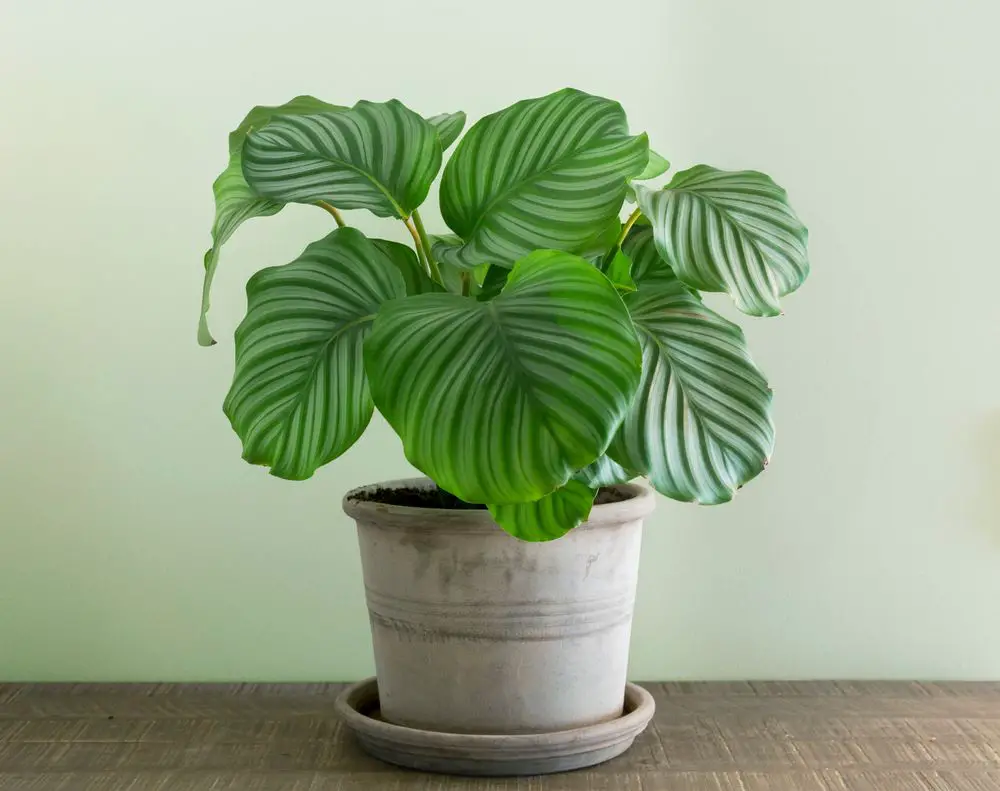Calathea is a houseplant known for its striking leaves. There are many Calathea varieties to choose from, and each type is unique. Regardless of what variety you choose, your Calathea foliage is eye-catching and a head-turner.
Calathea or Geoppertis is an herbaceous perennial houseplant from the Marantaceae (Maranta) and native to Columbia and Brazil. In Columbia, the Calathea leaves are used as containers. In Brazil, the leaves are used to wrap fish in transport. Below we describe 21 varieties of this plant and set out a full care guide.
Calathea Varieties
The Calethea plant is characterized by its long and broad leaves. Depending on the variety, some Calathea plants may have stripes and green, purple, cream, or cream markings. They typically also have a spread and height range of about 1 inch to 3 inches.
Calathea varieties are ideal for beginners, such as the Zebra and Pinstripe Calatheas. On the other hand, the Rosy and Peacock Caletheas are needier, but the results are worth it.
With several Calethea varieties to choose from, picking your favorite can be a challenging task. Each Calethea variety is striking and unique, making them one of the most popular houseplants. Some are easy to find while many are rare.
Each Calethea varieties are striking and unique making them one of the most popular houseplants today.
1. Calathea Lancifolia
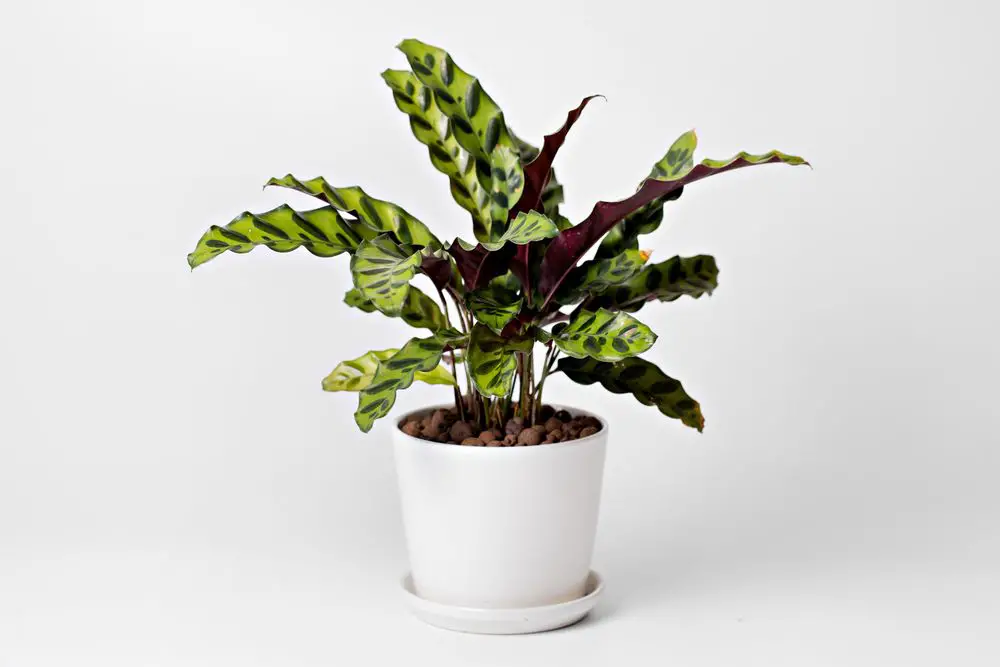
Calathea Lancifolia, or the Rattlesnake plant, has wavy, thin, and long leaves that are light green and dark green. The leaf itself is light green, and the darker green are interesting markings. The leaves have maroon undersides. The top of the leaves is light green with green spots.
The Rattlesnake Plant is hardy. It got its name because the marking on its leaves looks similar to a rattlesnake.
This Calathea is easy to care for. The tips of its leaves, though, are prone to leaf browning.
Calathea Roseopicta
The Calathea Roseopicta or Dottie plant has deep green foliage that looks almost black. This is one of the darker Calathea varieties.
The deep green burgundy leaves come with pink centers and borders and deep red-purple undersides.
Similar to other Calathea varieties, the Dottie plant can be challenging to look after. Nevertheless, it is a stunning plant.
3. Calathea Roseopicta
The Calathea Roseopicta, more popularly known as the Medallion Calathea, has round, broad leaves and purple undersides. The foliage has a dark green top with white and light green feathered rings.
There are several versions of the Calathea Roseopicta, but the Medallion is what is grown as a houseplant.
The Medallion is easy to look after. This houseplant is not so prone to browning leaf tips as Prayer plants. This plant is known for the tips of its leaves having rich patterns.
4. Calathea Orbifolia
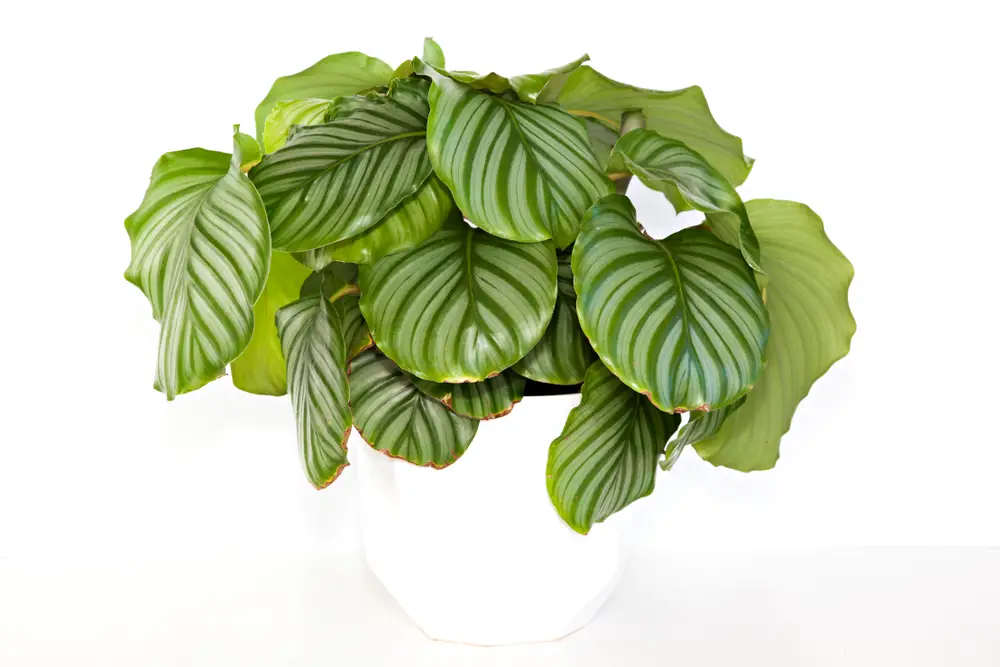
Calathea Orbifolia or Round Leaf Calathea is the Calathea with the largest leaves at about 8 to 12 inches wide. It can also be large, growing to be about 2.5 feet when mature.
The Round Leaf Calathea has round, broad, and green leaves. Some silvery cream and light green stripes come out from the leaves’ ribs.
Unlike other Caletheas, this plant does not have leaves with maroon undersides. It instead has green glossy leaves with candy-colored stripes.
5. Calethea Ornata
The Calethea Ornata or Pinstripe Calathea is characterized by its long dark green leaves (about 12 inches) with parallel, thin, pale pink stripes. It also has maroon undersides.
The pinkish-white stripes look as though they were painted on the leaves. It has burgundy stems.
This tall plant is one of the hardier Calathea varieties making it easy to care for.
6. Calathea Lietzei
The Calathea Lietzei or White Fusion is recognized by its lanced-shaped leaves having silver and white variegation. Unlike other Calathea varieties, it has pale lavender undersides. The top of its leaves has deep green broad stripes alternating with wide white stripes.
This plant is one of the prettiest Calathea and not the easiest to find. It is one of the hardest to care for and not recommended for beginner Calathea growers.
This Calathea plant is nicknamed the Peacock Plant. It should, however, be differentiated from the Calathea Makoyana which is also referred to as the Peacock Plant or Cathedral Windows.
7. Calathea Crocata
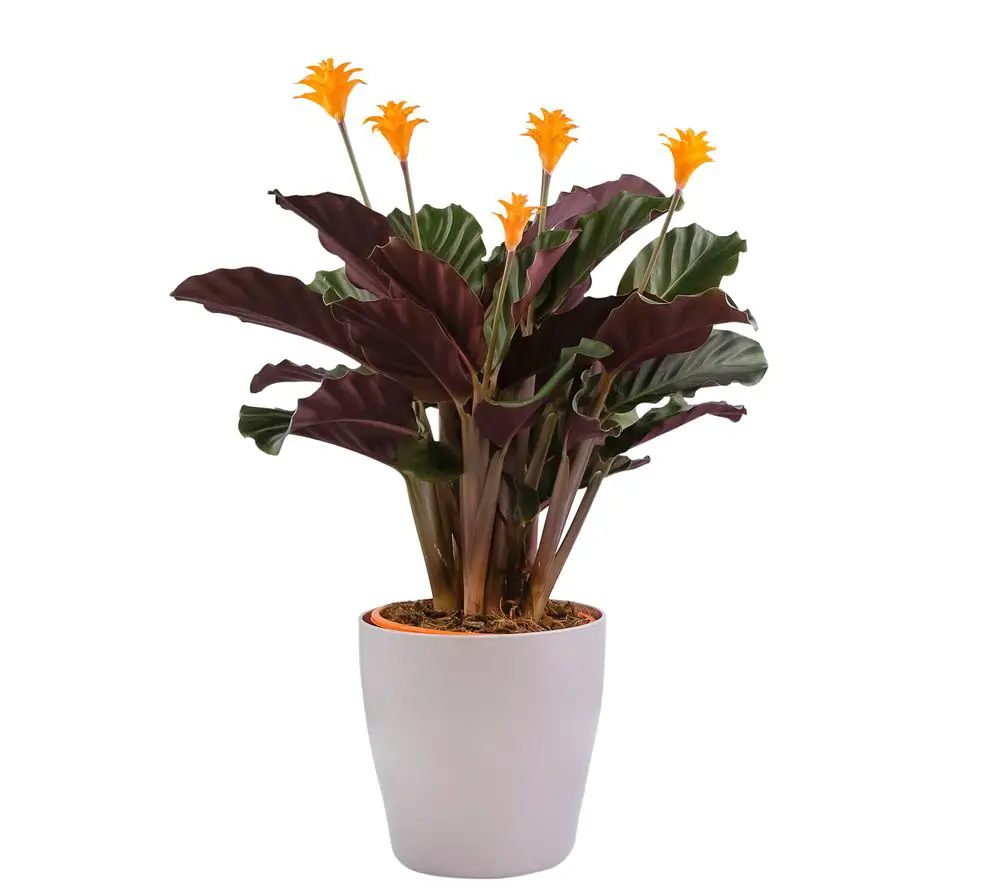
The Calathea Crocata is nicknamed the Eternal Flame Plant because its brilliant orange flowers grow above the leaves resembling a flame rising out of the leaves. This plant comes with ruffles and lance-shaped dark green leaves.
This Calathea Plant thrives on very bright indirect light, especially nearly direct morning light. It is an easy Calathea plant to grow and is ideal for beginner Calathea growers.
8. Calathea Micans
Calathea Micans or Silver Stripe is an evergreen with simple alternate leaves (petiolate, entire, and ovate). It has clusters of white funnel-shaped flowers that grow from June to August.
This evergreen prefers moist soil (gritty loam, sandy loam, or sandy clay) and a half-shady location. It can only tolerate temperatures above 330F.
9. Calathea Musaica
Calathea Musaica or Network Calathea has foliage that is covered with elaborate patterns of crosshatch, thin lines. The foliage of this plant has a pretty mosaic-like appearance.
The Network Calathea has glossy and dark green leaves with light green patterns of lines. Unlike other Calethea, it has green undersides.
10. Calathea Makayana
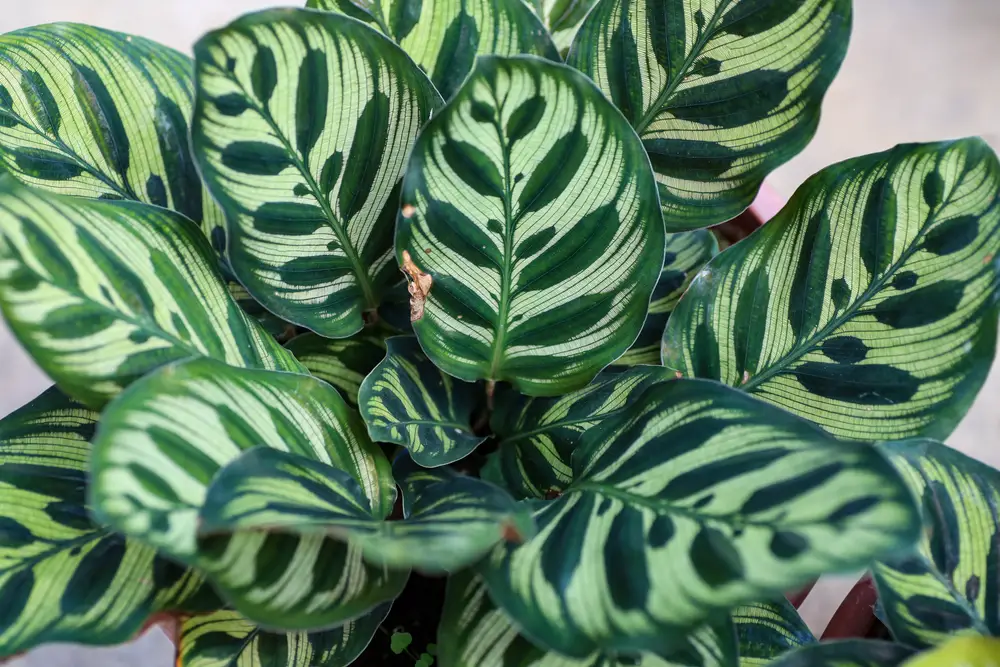
The Calathea Makoyana or Peacock Plant has green leaves patterned with thin and dark lines sprinkled with larger ovals. The patterns of the leaves mimic peacock feathers.
This plant is also known as the Cathedral Calathea because of its slim leaves (unlike most Calatheas) that grow in beautiful shades of purple and deep green with lime green markings that look similar to Cathedral windows.
The undersides of the leaves are not maroon, but instead, replicate the pattern on top of the leaves. It thrives in very bright indirect light and with very high humidity.
11. Calathea Rufibarba
Calathea Rufibarba or commonly known as the Furry Leather or Velvet Calathea is a soft plant. This plant is recognized for having furry, velvety, and lance-shaped green leaves.
Its foliage is not as attractive as other Calathea varieties, but it has unique leaf undersides and long burgundy stems covered in a hair-like fashion. The leaves grow on top of light green and long stems.
The Furry Leather plant is a Calathea variety with one of the most unique leaf shapes. It should not be confused with the similar-looking Calathea Lancifolia.
This plant is a good choice if it is intended to be placed in low-light settings.
12. Calathea Concinna
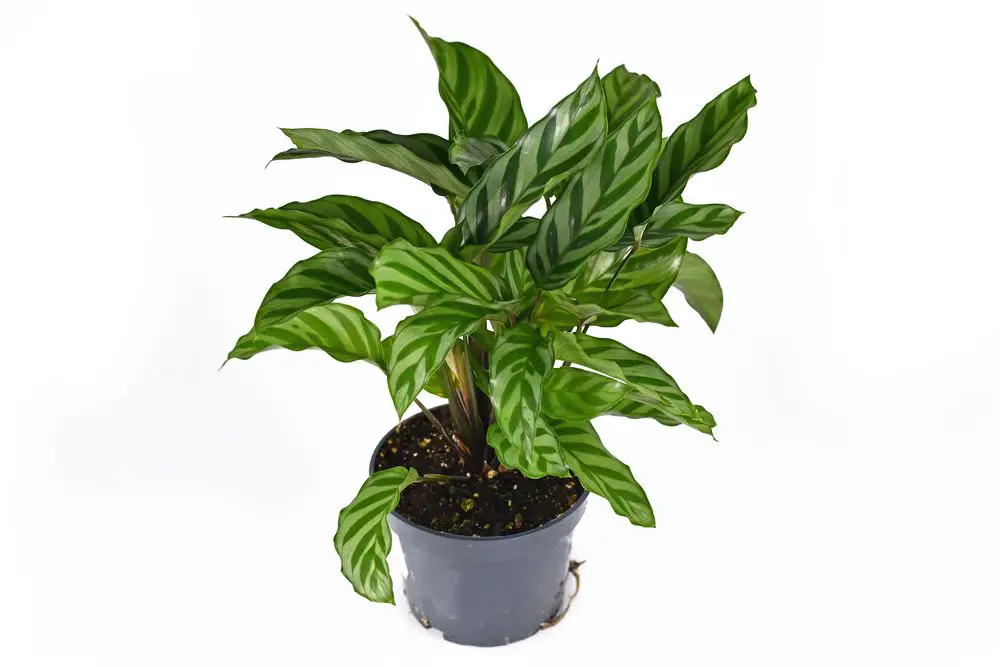
The Calathea Concinna goes with its common name, “Freddie.” It is one of the easiest Calathea varieties to grow. This plant comes with large, light green, and oval-shaped pointed leaves with dark green and feathery veining.
This plant repeatedly produces white flowers. It is a pretty plant that attracts butterflies, bees, and birds. It is an ideal indoor plant as well as a perfect groundcover.
The “Freddie” plant prefers bright indirect sunlight and high humidity. It also needs regular watering and the soil should not be allowed to be dry between watering.
13. Calathea Zabrina
Calathea Zebrina or Zebra Plant comes with big, oval-shaped light green leaves and with dark green horizontal stripes. It is called the Zebra plant because its foliage has zebra-like stripes. This plant also has green stems.
Many gardeners grow the Zebra Plant because of its beautiful leaves. It does not usually produce blooms but when grown indoors you will not miss seeing the blooms.
The Zebra Plant prefers filtered sunlight and high humidity (warm temperatures). You can increase the humidity around the Zebra Plant by adding more plants beside it. This plant can grow full and tall when given proper care.
14. Calathea Vittata
The Calathea Vittata has large and teardrop-shaped leaves with bright yellow and deep green stripes. It has burgundy undersides.
The leaves of this plant fold up during the night and unfold in the morning earning the moniker, “Prayer Plant.”
The beautiful pattern of the leaves of this plant makes it look like a piece of art.
This indoor plant does not require much care, but will not thrive outdoors. This rare plant requires bright indirect sunlight, warmth, and high humidity.
15. Calathea Beauty Star
The Calathea Beauty Star is a perennial with narrow, long dark green leaves with white, silver, and paler green stripes, as well as rich purple undersides. It is fairly dense and has a beautiful upright growth
The Beauty Star is a well-loved houseplant because of its vivid leaf patterns. Similar to other Calathea varieties of the Marantaceae family, the leaves of the Beauty Star lower at night and rise again in the morning like in prayer, thus, earning for itself the nickname “Prayer Plant.
This plant loves bright indirect light coming from a north-facing window. It requires moist and well-draining soil, high humidity with warm temperature of between 650F and 850F. It also needs a monthly sprinkle of balanced fertilizer, especially from April to October.
16. Calathea Lutea
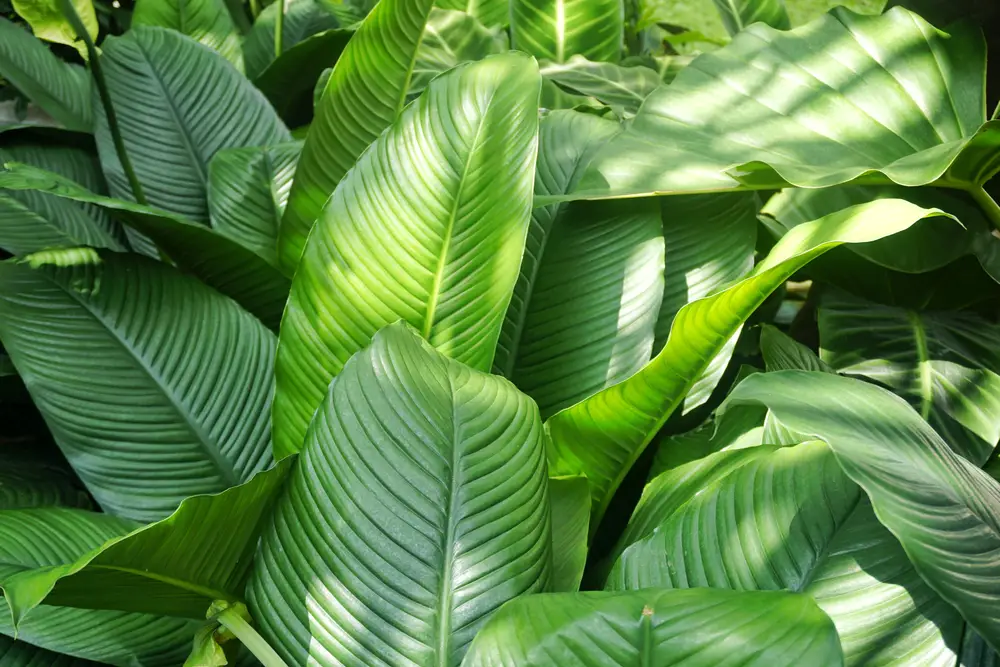
The Calathea Lutea has large paddle-shaped leaves. It also has brown cigar-like flowers, thus it is commonly called “Cigar Calathea” or the Havana Cigar plant.
The Cigar Calathea is an ideal choice for landscapes in Balinese or tropical-style gardens in tropical settings. It is also a good plant for a balcony.
When grown indoors, this plant requires bright and overhead light to prevent it from growing at a weird angle.
The large leathery leaves of this plant are used in its native settings for wrapping items that need to be waterproofed or for thatching roofs.
17. Calathea Marantifolia
The Calathea Maranttifolia is one of the Calathea varieties known as a Banana Plant-like Calathea.
It has large, thin broad stalked leaves that grow densely mimicking a banana plant with shorter shapes and curly veins.
The entire Calathea Maranttifolia foliage is forest green, including its undersides. It also has green inflorescences with corncob-shaped yellow flowers, thus it is also called Sweet Corn Root.
18. Calathea Warscewiczii
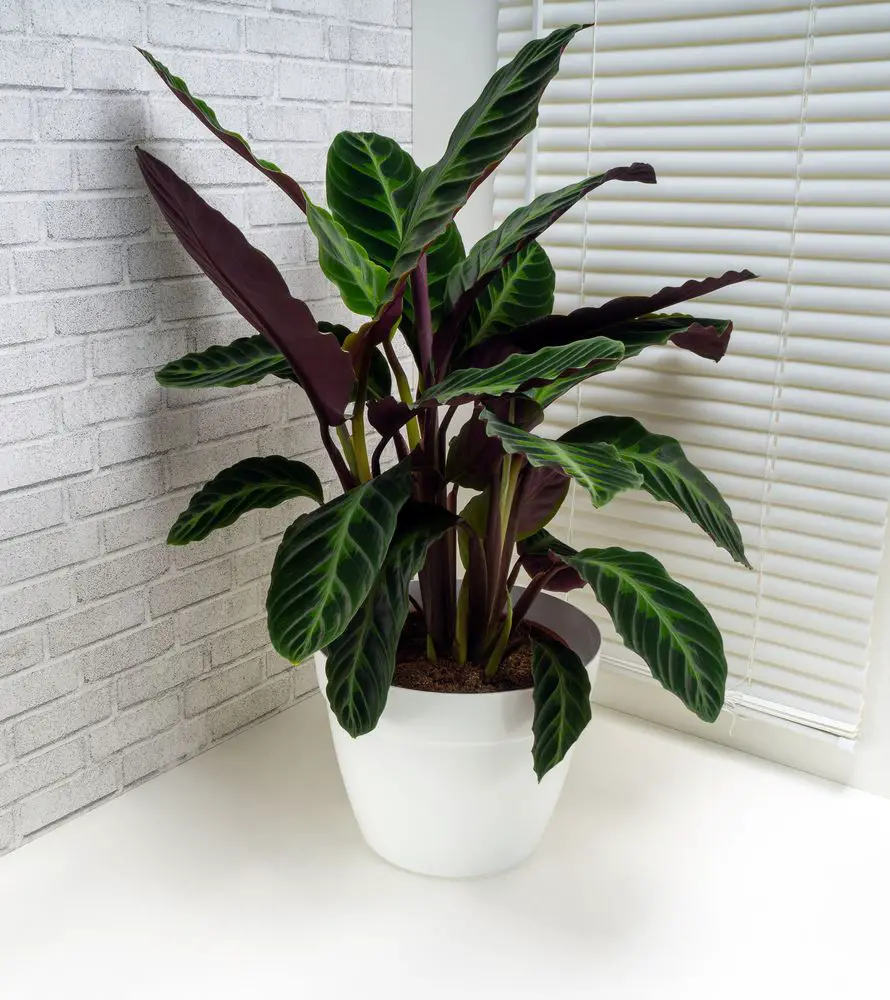
The Calathea Warscewiczii is usually known as the Jungle Velvet plant because it comes from the jungles of Costa Rica and Nicaragua.
This Calathea variety has deep green, lanced-shaped, and velvety leaves with light green leaf pattern. It has deep maroon undersides with a more velvety feel to the touch.
This plant requires bright indirect light. It should be planted in moist and well-draining soil and high humidity.
19. Calathea Fasciata
The Calathea Fasciata is one of the Calatathea varieties that is also called the Prayer Plant because its leaves fold at night and unfold in the morning.
This plant is also sometimes known as the Calathea Rotundifolia Fasciata.
This Calathea is a popular indoor plant. It is a flowering plant with shiny, round, thick, big leaves with dark green veins.
It comes with purple undersides. Its light and dark green stripes make this plant extremely attractive to growers and plant lovers.
20. Calathea Corona
The Calathea Corona is popular with those who want to grow a collector’s plant, but cannot afford its price.
Being a “Prayer Plant,” its leaves fold at night similar to hands folded in prayer and unfolds in the morning.
This plant has spectacular patterned foliage. It has olive-green shiny leaves with bright silvery-gray highlights at the center and dark edges.
New or young leaves are curled and show off their purplis- red undersides as they mature. Each round leaf is broad and taper. The stems are concealed by its dense foliage.
21.
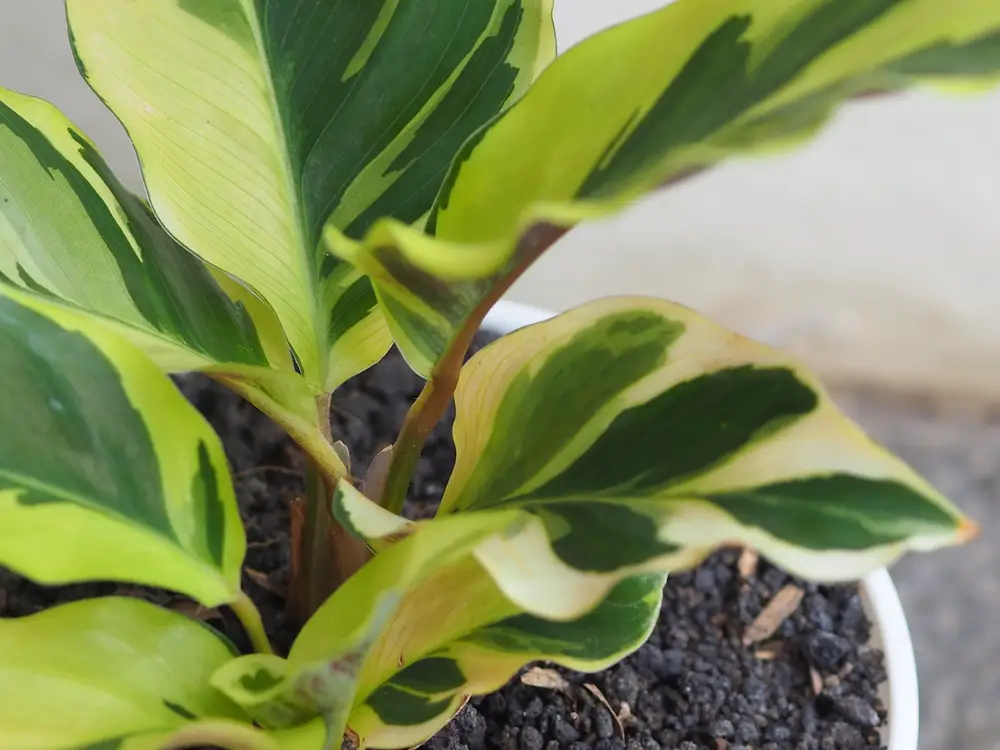
Calathea Louisae is more popularly called Thai Beauty. The ornamental leaves of this plant are ovate and broad.
The leaves are deep green with pale greenish-white feathery stripes on the center of each leaf. It has purple undersides.
It is also called the “Prayer Plant” because the plant gently lifts its leaves similar to the position of praying hands. The leaves get back to their normal position in the morning.
The Calathea Louisae is hardy in USDA Zones 8-11. It can also grow in the Southern non-tropical USA. It may, however, die during winter.
Calathea Growing Conditions
All Calathea varies are popular indoor houseplants. They can also be grown outdoors in semi-tropical and tropical settings.
Provide your Calathea plants with the best growing conditions to ensure you can have interesting and eye-catching plants.
Soil
Calatheas require fertile and well-draining soil. An ideal houseplant potting mix should have 25% additional peat moss.
Light
All Calathea varieties thrive best in shaded settings from partial shade to full shade. Bright indirect light is the best setting for your Calathea plant.
Temperatures
Calatheas are tropical plants, thus they require warm indoor temperatures of 600F to 800F.
They also need high humidity because low levels of humidity can cause the tips of the leaves to dry up.
Low humidity can also cause leaf curling, brown edges, and leaf browning.
Fertilizer
Fertilize your Calathea plant every two during late spring to early fall (active growing season). Use half the strength of water-soluble houseplant fertilizer.
Watering
Calatheas only require moderate watering. You can use the soak and dry watering method.
This means deep watering and waiting for the soil (top 1 inch) to be dry before watering again. Make sure to avoid having soggy soil.
Calatheas are quite picky with the type of water. They resent water with bromine, chlorine, and fluoride, so it is a no-no to use tap water.
Instead of tap water, you need to water your Calatheas with distilled water or rainwater.
Overwatering can make your plant attractive to pests such as aphids, scale, and spider mites.
Propagation
You can propagate your Calathea plant by division when repotting. When due for repotting, your plant should have thick tubers in its thick roots and the tubers have 1 or 2 leaves.
You can plant the divisions in a pot. Make sure it is a few inches below the surface of the soil.
As mentioned, make sure, it is planted in a rich and well-draining potting mix. Make sure to also keep the soil warm and slightly moist.
Calathea Plants Care Tips
Almost all Calathea varieties require virtually the same care. In the world of houseplants, people tend to either love or hate Calatheas.
That is understandable because these plants can be ‘quite the diva.’
Calatheas can be difficult to maintain when you are new to them. They become easier to maintain once you know how to keep them happy in your home.
Here are some useful and basic care tips for all Calathea varieties.
Always place your Calathea plant in a spot with indirect light. Direct light can cause the leaves of your plant to fade and burn.
Spots with medium, indirect light is the most ideal location for your plant.
Calatheas grow naturally on the forest floor and are shaded by high shrubs and trees. They are, therefore, used to getting minimal light.
Calatheas grow well in humidity. The leaves of your plant will brown or curl when the air is too dry.
You can use a humidifier or place your pot on a pebble tray. You can also place some plants near your Calathea or place dampened mulch around your plant to increase the humidity.
Regular misting, placing a water globe, or placing small containers with water around your plant can increase humidity.
Water your plant only when the soil is dry (top 1 inch). Water slowly until you see water coming out of the drainage holes of your pot.
You can use a watering globe to keep the soil moist at all times without the soil swimming in water. In short, it can keep the soil damp but not soaked.
A watering globe is a blown glass container with thin long necks. The water stored in the globe is released slowly into the soil allowing your plant to have a steady supply of water.
Water your Calathea plant only with rainwater, distilled water, or filtered tap water Make sure the tap water is de-chlorinated.
You can de-chlorinate tap water by placing it in a clear containing. Allow the container to sit on your kitchen counter at least 24 hours before using it to water your Calathea.
You may also opt to regularly mist your plant. Misting may not boost humidity, but it gets rid of pests that attack and make your plant their home.
Calatheas typically bloom in the wild, but most Calatheas grown as houseplants do not.
You do not necessarily need to fertilize your plant but sprinkling regular houseplant fertilizer can make your Calathea produce beautiful blooms.
Aerate your plant often. Aerate it by poking a wooden chopstick into the soil. Aerate regularly before watering your plant. Aerating helps water and air circulate and down to the roots.
Your Calathea does not need regular pruning. You can keep your plant looking always beautiful by trimming off yellowed or brown leaves.
Your Calathea plant is pet friendly.
Other Calathea Varieties
The Calathea Freddie is considered by many Calathea growers as one of the Calathea varieties that requires the least care and maintenance.
Some growers also say the Calathea Rufibarba is also low in maintenance.
The thicker leaves of the Freddie and Rufibarba are not as delicate as Calatheas with intricate patterns.
Experienced Calathea growers say the Calathea White Fusion is notorious for being the fussiest of all Calathea varieties.
The white variegation of its leaves makes it difficult for photosynthesis. It is also picky about the levels of humidity.
General Facts About the Calathea
Calathea is derived from the Latin word “calathus” which means “basket.” This is so because Calathea flowers look similar to flowers in a basket.
The Calathea varieties are known for their contrasting and bright colors. They can make your home lively with bright colors of purples, pinks, and greens. They can, however, be rare finds.
The Calathea varieties are popular houseplants but they are rare because they face extinction in the wild because of the destruction of their natural habitat.
The Calatheas are cousins to the Maranta genus of which the Maranta Leuconeura or Prayer plant is a part. That is why it is common to hear of some the Calathea varieties being referred to as Prayers plants. Some Prayers plants are also commonly referred to as Calatheas.
Since some Calathea varieties look similar to Prayer Plants, their leaves also fold up at night. How does that happen?
Each Calathea leaf comes with a “joint” between the leaf and the stem. The “joints’ make the leaves fold up at night and unfold in the morning.
Final Thoughts – 21 Stunning Calathea Varieties You Will Love – Plus Care Guide
Calatheas are popular houseplants and are commonly used as decorative indoor plants.
The many Calathea varieties mentioned give you numerous options to choose from. Except for a few varieties, most Calatheas are easy to grow and care for.
What’s not to love about this amazing and beautiful plant?
Jenny Marie
Tribal Writer
Edited By
Patricia Godwin

